- Category: Articles
 Solving the Triple Constraints of Quality, Time and Costs
Solving the Triple Constraints of Quality, Time and CostsThermal cameras with very high focal length were previously exclusively developed for space and defence applications. Now they are available for the civil market and bring to the wind energy sector higher quality and performance, lower Health, Safety and Environment risks and similar competitive prices to existing solutions. Based on the research work of institutes like the Sandia National Laboratories, the Federal Institute for Materials Research and Testing (BAM), Fraunhofer and private companies, the optical and thermographic inspection of wind blades becomes state of the art, so that certification bodies accept the ground-based thermographic inspection method as equivalent to the standard rope access method.
By Fabianna Tenorio and Jürgen Austen, Hensoldt, Germany
- Category: Articles
A Techno-Economic Analysis of the Concept
 1.1 billion people worldwide (or approximately one in every five people) live without access to electricity. Electrification of geographically remote communities is particularly challenging. These communities exist in both the developed and developing worlds, with different economic development contexts within which electrification must occur.
1.1 billion people worldwide (or approximately one in every five people) live without access to electricity. Electrification of geographically remote communities is particularly challenging. These communities exist in both the developed and developing worlds, with different economic development contexts within which electrification must occur.By Mohamed Mamdouh Elkadragy, Karlsruhe Institute of Technology, Germany
- Category: Articles
 An Open-Source Tool for Optimising Renewable Energy Components within Mini-Grids
An Open-Source Tool for Optimising Renewable Energy Components within Mini-GridsHybrid mini-grids (HMGs) are an ideal solution for remote settlements without energy access. HMGs are typically sized and optimised with commercial software that comes with the usual limitations and is lacking in transparency. The Reiner Lemoine Institute has attempted to develop an open-source alternative to standard software for modelling and sizing HMGs.
By Sarah Berendes, Reiner Lemoine Institut, Germany
- Category: Articles
Innovative Floating Platform for Deploying XXL Turbines
The main focus on releasing the potential of deep-water wind is how to reduce costs to make it competitive with nearshore wind. Nearshore bottom-mounted wind is now generating at nearly half the cost of nuclear.
 |
 |
 |
One way to drive down costs is to go for bigger turbines where so-called XXL units with capacities of up to 20MW are being considered. But such large units demand very stable platforms to resist the large capsizing moments. Increased stability with a floating platform means increased size and this has implications for where they can be built, what facilities can be utilised for their build, and how they can be deployed to site. This article reviews the fundamental stability consideration and how it impacts the size of the established floating platform solution of ‘spar’ and ‘semi-submersible’. The author proposes an alternative solution combining the features and advantages of the ‘spar’ and ‘semi-submersible’ – termed a ‘multifloat-spar’ – and puts forward its advantages in helping to drive down the cost of deep-water wind.
By Graeme Mackie, Oceanflow Energy, UK
- Category: Articles
 Ensuring Successful Wind Projects Requires Access to Optimised Resource Data
Ensuring Successful Wind Projects Requires Access to Optimised Resource DataInvestors and developers need high-quality wind resource data for financial modelling, and, with the decline in subsidy supports both in the UK and elsewhere, ensuring accurate measurements is critical. Much of the attention in this regard has focused on whether meteorological (met) masts or remote sensing devices will win out as the technology of choice in the coming years. However, with each possessing strengths and weaknesses, there are a range of other site and project considerations that developers must factor into early-stage site prospecting in order to reduce costs and maximise returns over the lifetime of a project.
By Alistair Marsden, Dulas, UK
- Category: Articles
 Renewables and Block Chain Technology Unleash New Power Structures
Renewables and Block Chain Technology Unleash New Power StructuresWe’ve seen it in other industries—the disruption that occurs when new players with breakthrough technologies demolish old barriers. Remember when half the world’s population had never used a phone? For decades, telecommunication leaders were stymied, unable to imagine how to reach every village in the world. Then came wireless. Today a goat herder in Asia can have a mobile phone and instantaneous connection.
By Michael Lumbley, Michael Lumbley, Alternative Resource Group, USA
- Category: Articles
 Easy Vertical-Axis Wind Turbines
Easy Vertical-Axis Wind TurbinesHave you ever wanted to build a wind turbine yourself just for the fun of it or perhaps to generate power? Geodesic turbines have a mesmerising operational quality to them, easy enough to build and capable of performing work.
By Brandon Everhart, Geodesic Turbine, USA
Use of cookies
Windtech International wants to make your visit to our website as pleasant as possible. That is why we place cookies on your computer that remember your preferences. With anonymous information about your site use you also help us to improve the website. Of course we will ask for your permission first. Click Accept to use all functions of the Windtech International website.










